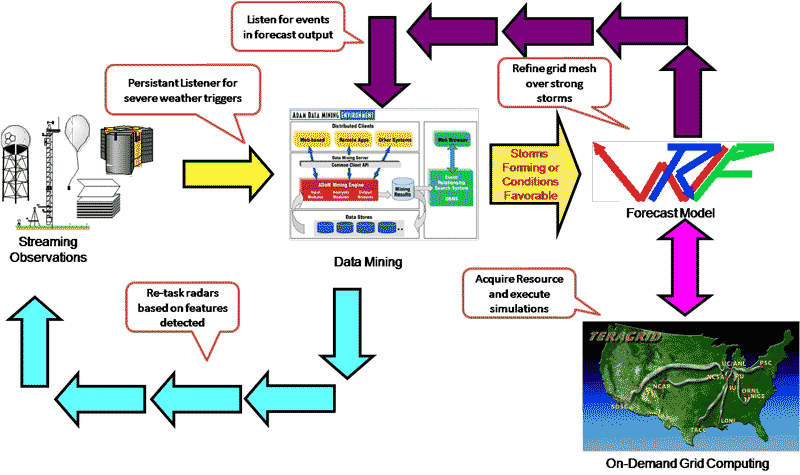To dynamically interact and react to weather events (Figure 2), LEAD is working on adaptivity in four categories:
- Weather simulation and prediction
- Data collection
- Use of computational resources
- LEAD Cyberinfrastructure
In the following paragraphs, we briefly elaborate on these categories.
Adaptivity in Simulations: In the simulation phase of the prediction cycle, adaptivity in the spatial resolution is essential in order to improve the accuracy of the result. Specifically, finer computational meshes are introduced in areas where the weather looks more interesting. These may be run as secondary computations that are triggered by interesting activities detected in geographic subdomains of the original forecast simulation. Or they may be part of the same simulation process execution if it has been re-engineered to use automatic adaptive mesh refinement. In any case, the fine meshes must track the evolution of the predicted and actual weather in real time. The location and extent of a fine mesh should evolve and move across the simulated landscape in the same way the real weather is constantly moving.
Adaptivity in Data Collection: If we attempt to increase the resolution of a computational mesh in a local region, we will probably need more resolution in the data gathered in that region. Fortunately, the next generation of radars being developed by Center for Collaborative Adaptive Sensing of the Atmosphere (CASA) 9 10 will be lightweight and remotely steerable. Hence, it will be possible to have a control service where a workflow can interact to retask the instruments to gain finer resolution in a specific area of interest. In other words, the simulation will have the ability to close the loop with the instruments that defined its driving data. If more resolution in an area of interest is needed, then more data can be automatically collected to make the fine mesh computationally meaningful. The relationship between LEAD and CASA is explained in detail in 11.

Adaptivity in Use of Computational Resources: Two features of storm prediction computations are critical. First, the prediction must occur before the storm happens. This faster-than-real-time constraint means that very large computational resources must be allocated as predicated by severe weather. If additional computation is needed to resolve potential areas of storm activity, then even more computational power must be allocated. Second, the predictions and assessment of uncertainty in the predictions can benefit from running ensembles of simulation runs that perform identical, or nearly identical, computations but start from slightly different initial conditions. As the simulations evolve, the computations that fail to track the evolving weather could be eliminated, freeing up computational resources. These resources in turn may be used by a simulation instance that needs more power. An evaluation thread must be examining the results from each computation and performing the ensemble analysis needed to gather a prediction. In all cases, the entire collection of available resources must be carefully brokered and adaptively managed to make the predictions work.
Adaptivity in LEAD Cyberinfrastructure: LEAD workflow infrastructure must respond to the dynamic behavior of the computational and grid resources in order to meet the requirement of “faster than real time” prediction. So a timely co-ordination of different components of the Cyberinfrastructure to meet soft, real-time guarantees is required. Co-ordination across the layers to allocate, monitor and adapt in real-time, while meeting strict performance and reliability guarantees and co-allocation of real-time data streams and computational resources, is required.






